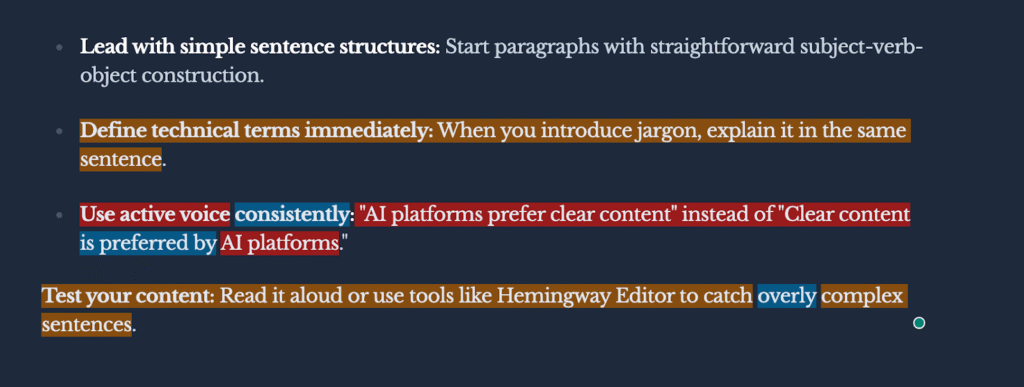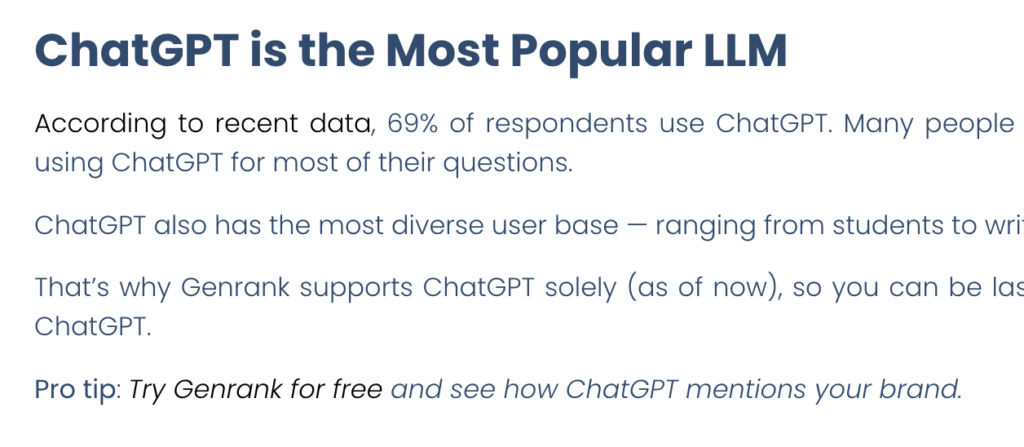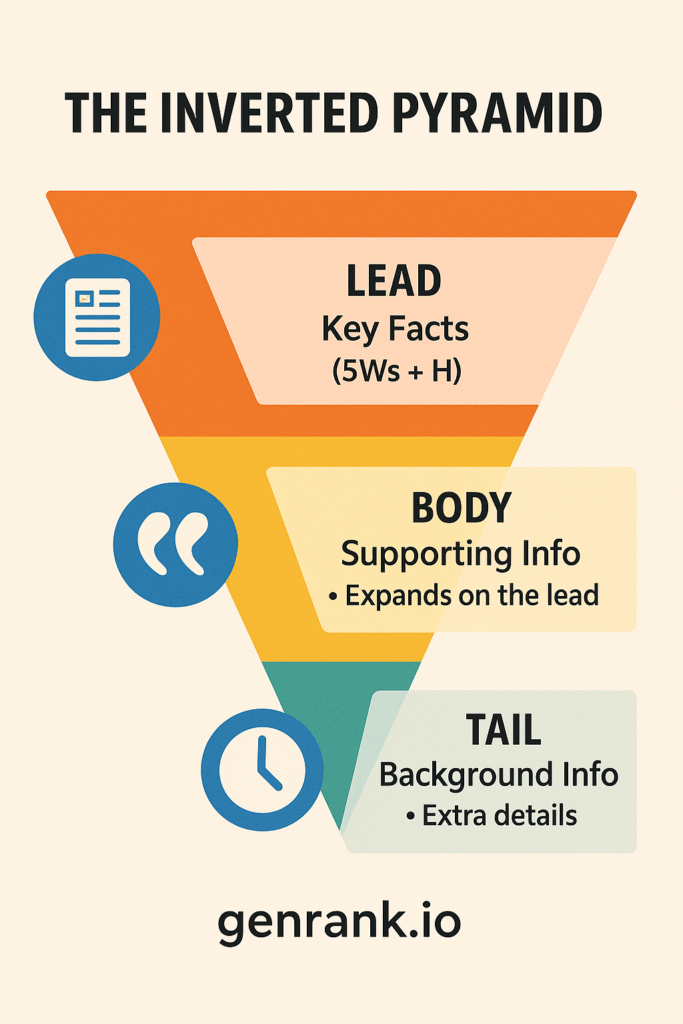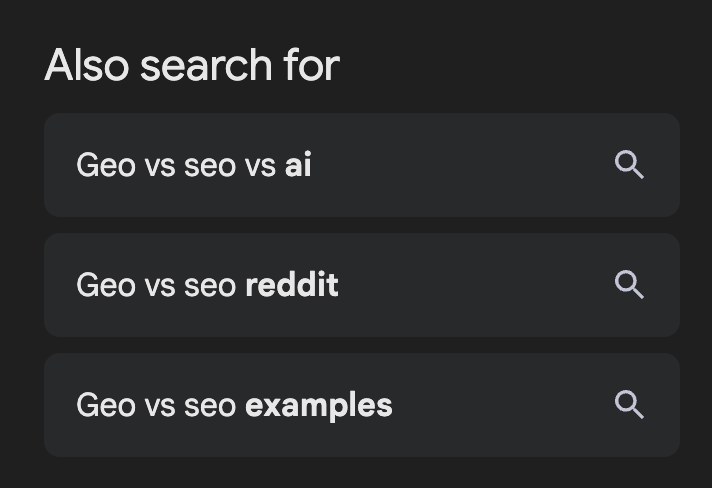Your beautifully crafted blog post has just been published. You’ve optimized it for Google, added the perfect keywords, and structured it flawlessly. But here’s the reality check: when someone asks ChatGPT, Claude, Perplexity, or any Large Language Models (LLMs) about your topic, your content is nowhere to be found.
While you’ve mastered traditional SEO, the fastest-growing segment of searchers has moved beyond Google. They’re asking AI platforms directly for recommendations, advice, and insights. And if your content isn’t optimized for these generative engines, you’re essentially invisible to this growing audience.
But here’s the good news. Getting cited by AI platforms isn’t about completely overhauling your content strategy. It’s about understanding how generative engine optimization differs from traditional SEO and adapting your writing approach accordingly.
This guide will show you exactly how to write blog posts that AI platforms love to cite.
Use Clear and Concise Language
AI platforms prioritize content that’s immediately understandable and actionable. This means writing at an accessible reading level, typically around 8th to 10th grade, without sacrificing the depth your expertise demands.
Why clarity matters for AI citations
AI models scan thousands of sources when generating responses. They’re more likely to pull snippets that express ideas cleanly in one or two sentences rather than digging through convoluted paragraphs to extract meaning.
This doesn’t mean dumbing down technical content. Instead, it means expressing complex ideas with precision and clarity. For example, instead of writing…
“The implementation of robust cybersecurity protocols necessitates a comprehensive understanding of multifaceted threat vectors.”
…you can write:
“Strong cybersecurity requires understanding different types of threats your business faces.”
Practical implementation tips:
- Lead with simple sentence structures: Start paragraphs with straightforward subject-verb-object construction.
- Define technical terms immediately: When you introduce jargon, explain it in the same sentence.
- Use active voice consistently: “AI platforms prefer clear content” instead of “Clear content is preferred by AI platforms.”
- Test your content: Read it aloud or use tools like Hemingway Editor to catch overly complex sentences.

Remember, AI platforms need to assess whether your content answers user queries quickly. Clear, direct language makes this process easy and increases your chances of being cited.
Structure Content with Headings and Lists
AI platforms excel at extracting information from well-structured content. Think of your blog post as a reference document that needs to be easily navigable by both humans and algorithms.
Why write descriptive headings
Your H2 and H3 headings should directly correspond to questions people ask AI platforms. Instead of “Our Approach,” use “How to Choose the Right Project Management Software.” This alignment makes your content immediately relevant when AI systems search for specific information.

This is also beneficial for your regular human readers, as they typically scan a blog post. Descriptive headings stand out easily and let them get the information they need.
How to write lists:
- Bullet points for discrete facts: Use bulleted lists for tips (just like this one!), benefits, features, or steps that can stand alone.
- Numbered lists for sequences: When order matters, numbered lists help AI understand the logical flow.
- Short paragraphs between lists: Keep paragraphs to 2-5 sentences to create focused information chunks.
Here’s a powerful technique: structure your lists so each bullet point could serve as a complete answer to a specific question. For instance, if discussing “Email marketing benefits,” each bullet should be comprehensive enough for AI to extract and cite independently.
Pro tip: Sign up for GenRank’s free trial to test how well your current content performs in AI responses. Create prompts related to your topics and see if your content is getting cited by ChatGPT.
Provide Direct Answers, Then Elaborate
The inverted pyramid structure, commonly used in journalism, works perfectly for AI optimization. Start with your conclusion or direct answer, then provide supporting details and context.

Why the inverted pyramid structure works
When someone asks an AI platform a question, the system searches for immediate and authoritative answers. If you bury your main point in the third paragraph, another source with upfront clarity will likely get the citation instead.
How to write in an inverted pyramid structure:
- Open with the answer: If someone asks, “Can you recycle cardboard boxes?”, start with “Yes, cardboard boxes are recyclable in most municipal programs.”
- Add immediate context: Follow with essential qualifications or exceptions
- Elaborate with details: Provide the how, why, and additional considerations
- Include supporting evidence: Add data, examples, or expert insights
For example:
Can you use questions as a heading? Yes, using questions is a good strategy because people usually start their search with a question. For example, this blog post is actually a question on Reddit.
This structure serves dual purposes: human readers get immediate value. AI platforms find clear, citable statements that directly answer user queries.
Include Keywords and Synonyms Naturally
AI platforms understand semantic relationships and context far better than traditional search engines, but strategic keyword usage still signals content relevance and topic coverage.
Updated keyword strategy for AI platforms
Focus on natural language patterns that match how people actually ask questions. If your audience asks, “How do I boost organic traffic from search?”, ensure your content includes that exact phrasing alongside variations like “optimize for SEO” and “improve clicks from Google.”
Semantic keyword implementation:
- Use question phrases as headings: “Why Does Email Timing Matter?” directly matches user queries
- Include synonyms contextually: Interchange “optimize” with “improve,” “enhance,” and “boost” where appropriate
- Address related concepts: Cover adjacent topics that AI might associate with your main subject
Avoid these keyword mistakes:
- Keyword stuffing that creates awkward, unnatural reading
- Forcing keywords into contexts where they don’t belong naturally
- Over-optimizing for exact phrases at the expense of comprehensive coverage
Use tools like Surfer SEO if you must, but make sure all of the keywords make sense and are not just used to boost the score or rating. Pro tip: Use the “Also Search For” feature on Google. Scroll to the end of the first page, and you’ll see the related phrases. This is great because it’s the actual phrases that people typed on Google.

The goal is to create content that comprehensively covers your topic using the language your audience naturally employs. This approach helps AI systems understand your content’s relevance while maintaining the quality that keeps human readers engaged.
For GEO content optimization, consider expanding beyond traditional keyword density to focus on topical authority and semantic completeness.
Maintain Authoritative Yet Neutral Tone
AI platforms prioritize content that demonstrates expertise without bias or excessive promotional language. Your tone should signal authority while remaining objective and helpful.
How to build an authoritative voice:
- Cite specific experience: “In our analysis of 500 SaaS companies, we found…” establishes credibility.
- Reference data and studies: Include statistics, research findings, and industry benchmarks.
- Acknowledge limitations: Honest assessment of when approaches don’t work builds trust.
- Use measured language: “Generally,” “typically,” and “in most cases” show nuanced understanding.
Avoiding AI citation killers
AI systems often skip overly promotional content or obviously biased sources. Instead of “Our amazing software is the absolute best solution,” try “This approach works well for companies with remote teams and complex project requirements.”
Balance and objectivity strategies
Present multiple viewpoints when relevant. If discussing email marketing tools, acknowledge that different solutions work better for different business sizes or industries. This balanced approach increases the likelihood that AI systems will use larger portions of your content.
Expert positioning without ego
Focus on providing value to the reader rather than promoting your services within the content body. Remember, AI platforms are looking for trustworthy sources to cite. Content that reads like a helpful expert consultation rather than a sales pitch gets cited more frequently and extensively.
Think of the general rules when writing a research paper, but with a conversational tone. It helps if you come from an academic background (like me). I was a literature major. It was extremely critical to cite sources correctly and present facts without embellishment. The same goes when writing for AI platforms and SEO. (But it should be the rule for writing about just anything!)
Read our detailed guide if you want to go beyond writing content and want a full GEO optimization checklist.
Start Getting AI Citations
If you want to start getting cited by AI platforms like ChatGPT, the rules are simple. In fact, the rules have existed long before ChatGPT came into existence.
Write clearly and concisely. Make sure to present facts accurately. And lastly, provide concrete examples and structured content. With a combination of good writing and technical structure, you’re on your way to appearing in ChatGPT’s responses.
Make sure to have a GEO tool to help you monitor your brand mentions in LLMs and AI platforms. Use a tool like Genrank to make it super easy to track prompts and mentions.
FAQs about Getting Cited in LLMs
How do I use AI to write a blog post?
Start with AI as a research and outlining assistant rather than a complete writing solution. Use ChatGPT or Claude to brainstorm topics, create content outlines, and research key points. Then write the content yourself, ensuring it reflects your expertise and voice. AI can help with editing, fact-checking, and optimizing for different audiences, but your original insights and experience make content citation-worthy.
How does ChatGPT crawl your blog posts?
ChatGPT doesn’t actively crawl websites like Google does. Instead, it accesses web content through its search functionality when users ask questions that require current information. Your blog posts can be discovered when ChatGPT searches the web to answer user queries.
How long should my blog posts be to get cited by AI platforms?
AI platforms cite content based on relevance and quality rather than length. However, comprehensive posts (1,500-3,000 words) that thoroughly cover topics tend to get cited more frequently because they’re more likely to contain complete answers to user questions. Focus on depth over length.
What’s the difference between writing for Google vs. writing for ChatGPT?
Google optimization focuses on ranking entire pages for specific keywords, while ChatGPT optimization targets getting cited within AI-generated responses.
For ChatGPT, you optimize for mentions and citations. Google rewards technical SEO factors like page speed and backlinks, while ChatGPT prioritizes content clarity, expertise signals, and comprehensive topic coverage.
How can I track if my content is being cited by AI platforms?
Use specialized tools like GenRank to monitor how ChatGPT mentions your brand and content. Set up prompts related to your industry and track whether your content appears in responses. You can also manually test by asking AI platforms questions related to your content topics and noting which sources get cited.
